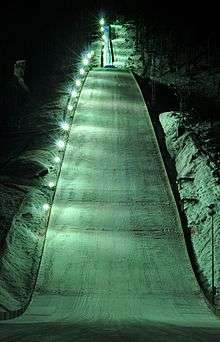Engelberg
Engelberg (lit.: mountain of angel(s)) is a village resort and a municipality in the canton of Obwalden in Switzerland. Besides the village of Engelberg, the municipality also includes the settlements of Grafenort, Oberberg and Schwand.
Engelberg | |
|---|---|
 View from Engelberg towards northeast with the snow covered Lauchernstock and the Ruchstock to the left, and the Gross Gemsispil to the right (mid-August 2007) | |
 Coat of arms | |
Location of Engelberg 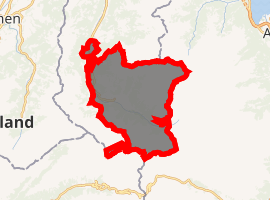
| |
 Engelberg 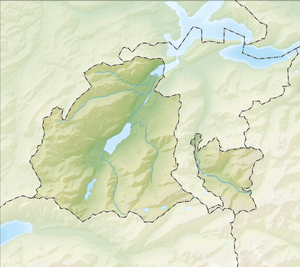 Engelberg | |
| Coordinates: 46°49′15.751″N 8°24′32.314″E | |
| Country | Switzerland |
| Canton | Obwalden |
| District | n.a. |
| Government | |
| • Executive | Gemeinderat with 5-7 members |
| • Mayor | Talammann Alex Höchli CVP/PDC (as of July 2016) |
| • Parliament | none (Talgemeinde) |
| Area | |
| • Total | 40.75 km2 (15.73 sq mi) |
| Elevation (The monastery's church) | 1,013 m (3,323 ft) |
| Highest elevation (Mount Titlis) | 3,238 m (10,623 ft) |
| Lowest elevation (Engelberger Aa in Grafenort) | 556 m (1,824 ft) |
| Population (2018-12-31)[2] | |
| • Total | 4,181 |
| • Density | 100/km2 (270/sq mi) |
| Demonym(s) | German: Engelberger(in) |
| Postal code | 6390 Engelberg, 6388 Grafenort |
| SFOS number | 1402 |
| Localities | Grafenort, Oberberg, Neuschwändi, Niederberg, Mühlebrunnen, Schwand, Obermatt, Gerschni, Horbis, Brunni, Herrenrüti, Fürenalp, Griessental |
| Surrounded by | Attinghausen (UR), Gadmen (BE), Innertkirchen (BE), Isenthal (UR), Wassen (UR), Wolfenschiessen (NW) |
| Website | www SFSO statistics |

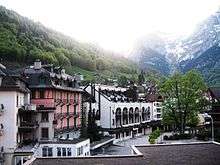
The municipality of Engelberg is an exclave of Obwalden, surrounded by the cantons of Bern, Nidwalden and Uri.
Engelberg is a major mountain resort in Central Switzerland. In the Middle Ages, Engelberg was known for the educational quality of its Benedictine monastery, Engelberg Abbey. From the 19th Century onwards Engelberg became internationally known as a mountain resort, but it is today visited as much for skiing as for its Alpine character. With its combination of modern snow and sports facilities and alpine location, Engelberg is popular today for both summer and winter tourism. The nearest large city is Lucerne.
The official language of Engelberg is (the Swiss variety of Standard) German, but the main spoken language is the local variant of the Alemannic Swiss German dialect.
History
Engelberg is first mentioned as Engilperc in 1122, when the Abbey was founded there, although the Alpine pasture of Trüebsee was already exploited collectively before this time.[3]
In August 1815, the canton of Nidwalden was slow to accept the Federal Treaty while Engelberg declared support. Nidwalden finally accepted the new treaty on 18 August 1815 after federal troops marched into the canton. As a result, Engelberg was transferred to the canton of Obwalden.[4]
From 1850, Engelberg became an international vacation resort (mineral water, milk serum and fresh air cures). Many hotels were built by the families Cattani, Hess and Odermatt, pioneers of tourism. From 1872 to 1874, a new, wider road was built, and the Stansstad-Engelberg electric railway was opened in 1898.[3]
Hiking and other mountain sports developed at the end of the 19th century and Engelberg first held a winter season in 1903–1904. A funicular railway (opened in 1913) connects Engelberg to Gerschni and, from there, the second cable car in Switzerland (opened in 1927) runs onwards to Ober Trüebsee. The decade preceding the First World War was a period of boom conditions (165,922 visitor-nights in 1911). The widening of the road and the extension of the railway to Lucerne (in 1964) considerably opened up the tourism catchment area of the station and, in 1967, the higher section of the Titlis cable car was opened. Recently, regular conferences in Engelberg came to supplement winter tourism. In 2000, the tertiary sector, especially tourism, offered three quarters of the employment of Engelberg.[3]
Geography
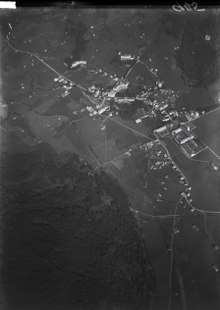
Engelberg is situated within the Uri Alps mountain range.
Engelberg is surrounded by major mountain summits, such as Titlis in the south (3,238 metres (10,623 ft)) above sea level), the Walenstöcke (2,572 metres (8,438 ft)) and Ruchstock (2,813 metres (9,229 ft)) to the north, Hahnen (2,606 metres (8,550 ft)) and Wissberg (2,627 metres (8,619 ft)) to the east, the Engelberger Rotstock (2,819 metres (9,249 ft)) and the Wissigstock (2,887 metres (9,472 ft)) to the northeast, and the upper valley of the Engelberger Aa leading to the Surenen Pass (2,291 metres (7,516 ft)) leading to the Urner Reusstal.[5]
Engelberg has an area, (as of the 2004/09 survey) of 74.87 km2 (28.91 sq mi).[6] Of this area, about 27.1% is used for agricultural purposes, while 25.8% is forested. Of the rest of the land, 3.7% is settled (buildings or roads) and 43.5% is unproductive land. In the 2013/18 survey a total of 146 ha (360 acres) or about 1.9% of the total area was covered with buildings, an increase of 35 ha (86 acres) over the 1980/81 amount. Over the same time period, the amount of recreational space in the municipality increased by 34 ha (84 acres) and is now about 0.61% of the total area. Of the agricultural land, 685 ha (1,690 acres) is fields and grasslands and 1,424 ha (3,520 acres) consists of alpine grazing areas. Since 1980/81 the amount of agricultural land has decreased by 156 ha (390 acres). Over the same time period the amount of forested land has increased by 103 ha (250 acres). Rivers and lakes cover 78 ha (190 acres) in the municipality.[7][8]
The average altitude of Engelberg is 1,020 m (3,350 ft). However the village is surrounded by the Alps, creating very steep terrain. The highest point in the borders of the municipality is the Titlis. The Engelberg Valley (German: Engelbergertal) is drained by the Engelberger Aa, a tributary of Lake Lucerne. The valley is located southwards from the lake.[5]
Transport
The municipality of Engelberg is served by two stations on the Luzern–Stans–Engelberg line. Engelberg railway station is located in the village and is the terminus of the line. Grafenort station is to the north, one station away. Both stations are served by hourly InterRegio trains from the city of Lucerne.[9]
A free bus system provides daytime transport within the village, with a network of seven routes during the winter season (from December through to April) and a single route during the summer season (from April until October).[10]
Tourism
The major tourist activities in the village and surrounding area are skiing and other snow sports in the winter season, and hiking and mountain activities during the summer.
In the village itself the main sights are the Benedictine monastery Engelberg Abbey which incorporates a cheese factory and demonstration shop, the Talmuseum showing the history of the area and Swiss rural life, and a number of old chapels.
The winter sports season generally lasts from December until April, although the high altitude glacier areas on the Titlis can sometimes be used (by advanced skiers) from October until May.[11] Snow coverage is generally reliable, although in recent years artificial snow machines have been installed on some of the lower altitude runs in order to improve snow cover.
Engelberg hosts a round of the ski jumping World Cup at the Gross-Titlis-Schanze jump.

In common with the rest of Switzerland, there is a village celebration for Swiss National Day on 1 August, with parades and events throughout the day.
On the last Saturday in September the Alpabzug takes place, when the cattle are brought from the mountain pastures back to their winter barns in the village and valley.
There are three main mountain areas, accessible from the village, offering various activities in winter and summer. The cable cars generally run all year round, providing access for hikers and mountain bikers as well as skiers.
Titlis
The Titlis in the south of Engelberg at 3,238 metres (10,623 ft) above sea level is the highest summit of the range north of the Susten Pass, between the Bernese Oberland and Central Switzerland.
The Titlis mountain massif is accessible by cable cars of the Titlis Bergbahnen. The cable car bottom station is also the central terminus of the village bus services. A funicular railway (dating from 1913) runs up to station Gerschnialp (1,267 m (4,157 ft)) and a wide Alpine pasture called Gerschni, with easy snow areas suitable for beginners and cross country ski trails, and a toboggan run leading back down to the valley station. In the summer there are two cheese dairies, with walking trails leading up to Ober Trüebsee and back down to the village, or level trails leading to Unter Trüebsee to the west.
The "Titlis Xpress" gondola lift, opened in 2015 to replace an older one dating from the 1970s, runs from the valley station (996 m (3,268 ft)) up to the middle station Trübsee (1,788 m (5,866 ft)) and on to Stand (2,428 m (7,966 ft)). This area provides more challenging skiing, on the lower slopes of the Titlis and via further chair lifts to the Jochpass (2,207 m (7,241 ft)) and below the Jochstock at 2,508 m (8,228 ft). A continuous ski piste leads down to Unter Trüebsee and back to the cable car valley station. In summer the lake is a popular walking area, with rowing boats available on the lake and picnic places around it. Walking routes lead over the Jochpass to Engstlenalp and Melchsee-Frutt, or directly from Engleberg over the Juchli Pass (2,171 m (7,123 ft)) or Storegg Pass (1,742 m (5,715 ft))) into the Melchtal.
The "Rotair" cable car ("the world's first rotating cable car") runs up to the Kleintitlis mountain station (3,028 m (9,934 ft)) where there is a restaurant and shops, an observation terrace and access to the glacier and summit. The high altitude glacier runs down from the peak are suitable for advanced skiers, with off-piste routes leading down to Trüebsee and the Laubersgrat ridge.
Brunni
The Brunni mountain area, to the north of the village, is accessible from the cable car station which runs up to Ristis (1,600 m (5,200 ft)), with a further chair lift up to Brunnihütte (1,860 m (6,100 ft)). The ski runs here are of a beginner to medium standard, although sometimes not having so much snow cover as the Titlis side due to the south facing aspect. There is another toboggan run from Brunnihütte back down to Ristis. In summer there are a number of walking trails starting from here, including the Walenpfad leading to Bannalp and the Rot Grätli ridge across the mountains to the north and northeast. There are also a number of prepared rock climbing routes (German: Klettersteig).
Fürenalp
At the eastern end of the Engelberg valley, there is a cable car up to Fürenalp (1,840 m (6,040 ft)), passing over the Fürenwand rock climbing area. From the top station or from the valley, summer walking routes with views of the Chli Spannort (3,140 m (10,300 ft)) and Gross Spannort (3,198 m (10,492 ft)) mountain peaks lead to the Surenenpass (2,291 m (7,516 ft)) in the east.
Heritage sites
Engelberg is home to three sites that are Swiss heritage sites of national significance; Engelberg Abbey with its library, archives and music collection, the mansion (Herrenhaus) in Grafenort and the Holy Cross chapel in Grafenort.[12]
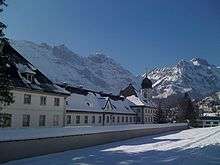 Benedictine Abbey
Benedictine Abbey Mansion in Grafenort with Garden Pavillon
Mansion in Grafenort with Garden Pavillon Holy Cross Chapel
Holy Cross Chapel
Demographics
The historical population is given in the following table:[3]
| Year | Population |
|---|---|
| 1709 | 678 |
| 1799 | 1,468 |
| 1850 | 1,737 |
| 1900 | 1,973 |
| 1950 | 2,544 |
| 2000 | 3,544 |
| 2010 | 3,859[13] |
Engelberg has a population (as of December 2018) of 4,181.[14] As of 2016, 26.2% of the population are resident foreign nationals. In 2015 a small minority (259 or 6.3% of the population) was born in Germany.[15] Over the last 6 years (2010-2016) the population has changed at a rate of 5.92%. The birth rate in the municipality, in 2016, was 8.3, while the death rate was 5.8 per thousand residents.[8]
As of 2016, children and teenagers (0–19 years old) make up 17.7% of the population, while adults (20–64 years old) are 61.4% of the population and seniors (over 64 years old) make up 20.9%.[8] In 2015 there were 1,762 single residents, 1,808 people who were married or in a civil partnership, 230 widows or widowers and 297 divorced residents.[16]
In 2016 there were 1,925 private households in Engelberg with an average household size of 2.10 persons. In 2015 about 43% of all buildings in the municipality were single family homes, which is about the same as the percentage in the canton (44.4%) and less than the percentage nationally (57.4%).[17] Of the 1,302 inhabited buildings in the municipality, in 2000, about 48.5% were single family homes and 34.4% were multiple family buildings. Additionally, about 17.1% of the buildings were built before 1919, while 9.4% were built between 1991 and 2000.[18] In 2015 the rate of construction of new housing units per 1000 residents was 8.3. The vacancy rate for the municipality, in 2017, was 0.92%.[8]
Most of the population (as of 2000) speaks German as their mother tongue (88.2%), with Serbo-Croatian being second most common (2.5%) and English being third (2.2%).[19] As of 2000 the gender distribution of the population was 49.9% male and 50.1% female.
Politics
In the 2015 federal election small, local parties received 53.5% of the vote and the SVP received the remainder (46.5%). In the federal election, a total of 1,476 votes were cast, and the voter turnout was 56.4%.[20]
In the 2007 election the most popular party was the SVP which received 37.4% of the vote. The next three most popular parties were a variety of other parties (not major) (28.6%), the CVP (22.7%) and the SPS (11.3%).
Education
In Engelberg about 65.5% of the population (between age 25-64) have completed either non-mandatory upper secondary education or additional higher education (either university or a Fachhochschule).[19]
Religion
Religion in Engelberg - 2010[13]
Business and industry
Engelberg is classed as a tourist community.[21]
As of 2014, there were a total of 2,547 people employed in the municipality. Of these, a total of 143 people worked in 56 businesses in the primary economic sector. The secondary sector employed 267 workers in 54 separate businesses, of which 6 businesses employed a total of 117 employees. Finally, the tertiary sector provided 2,137 jobs in 372 businesses.[22]
In 2016 a total of 8.3% of the population received social assistance.[8] In 2011 the unemployment rate in the municipality was 1.1%.[23]
In 2015 local hotels had a total of 354,960 overnight stays, of which 67.1% were international visitors.[24]
In 2015 the average cantonal, municipal and church tax rate in the municipality for a couple with two children making CHF 80,000 was 5.5% while the rate for a single person making CHF 150,000 was 11.1%, both of which are much lower than the average for the canton. The canton has a slightly higher than average tax rate for those making CHF 80,000 and one of the lowest for those making CHF 150,000. In 2013 the average income in the municipality per tax payer was CHF 88,070 and the per person average was CHF 45,328, which is greater than the cantonal averages of CHF 87,563 and CHF 38,842 respectively It is also greater than the national per tax payer average of CHF 82,682 and the per person average of CHF 35,825.[25]
Due to the risks of filming in the disputed region of Kashmir, many Indian films requiring a Kashmir snowy mountain have been filmed in Engelberg in recent past.[26][27]
Cultural references
Engelberg is mentioned in chapter XXIV of Henry James's 1875 novel Roderick Hudson.
Climate
Between 1981 and 2010 Engelberg had an average of 154 days of rain or snow per year and on average received 1,510 mm (59 in) of precipitation. The wettest month were July or August with 185 mm (7.3 in) of precipitation over 15.2 days. However June had the most precipitation days (15.9) but only 179 mm (7.0 in). The driest months of the year were January and February with 90 mm (3.5 in) of precipitation over 10.4 days.[28]
This area has a long winter season, with little precipitation mostly in the form of snow, and low humidity. The Köppen Climate System classifies the climate in Engelberg as Oceanic.[29] MeteoSwiss's classification is Central Alpine northslope.[28]
| Climate data for Climate normals Engelberg (reference period 1981-2010) at 1,036 metres (3,399 ft) | |||||||||||||
|---|---|---|---|---|---|---|---|---|---|---|---|---|---|
| Month | Jan | Feb | Mar | Apr | May | Jun | Jul | Aug | Sep | Oct | Nov | Dec | Year |
| Average high °C (°F) | 1.7 (35.1) |
2.7 (36.9) |
6.6 (43.9) |
10.6 (51.1) |
15.7 (60.3) |
18.5 (65.3) |
20.7 (69.3) |
19.9 (67.8) |
16.1 (61.0) |
12.2 (54.0) |
5.7 (42.3) |
2.4 (36.3) |
11.1 (52.0) |
| Daily mean °C (°F) | −2.1 (28.2) |
−1.4 (29.5) |
1.9 (35.4) |
5.5 (41.9) |
10.1 (50.2) |
13.0 (55.4) |
15.1 (59.2) |
14.6 (58.3) |
11.2 (52.2) |
7.5 (45.5) |
1.9 (35.4) |
−1.2 (29.8) |
6.3 (43.3) |
| Average low °C (°F) | −5.8 (21.6) |
−5.4 (22.3) |
−2.3 (27.9) |
0.9 (33.6) |
5.1 (41.2) |
8.1 (46.6) |
10.3 (50.5) |
10.1 (50.2) |
7.0 (44.6) |
3.7 (38.7) |
−1.5 (29.3) |
−4.6 (23.7) |
2.1 (35.8) |
| Average precipitation mm (inches) | 91 (3.6) |
90 (3.5) |
104 (4.1) |
120 (4.7) |
140 (5.5) |
179 (7.0) |
184 (7.2) |
185 (7.3) |
112 (4.4) |
96 (3.8) |
109 (4.3) |
97 (3.8) |
1,510 (59.4) |
| Average snowfall cm (inches) | 81.6 (32.1) |
81.9 (32.2) |
77.6 (30.6) |
35.6 (14.0) |
5 (2.0) |
0 (0) |
0 (0) |
0 (0) |
0 (0) |
9.5 (3.7) |
46.3 (18.2) |
76.8 (30.2) |
414.3 (163.1) |
| Average precipitation days (≥ 1.0 mm) | 11.4 | 10.4 | 13.6 | 12.9 | 14.9 | 15.9 | 15.2 | 14.3 | 12.0 | 10.3 | 11.4 | 11.7 | 154 |
| Average snowy days (≥ 1.0 cm) | 8.4 | 8.1 | 7.8 | 5.4 | 0.8 | 0 | 0 | 0 | 0 | 0.7 | 5.2 | 8.3 | 44.7 |
| Average relative humidity (%) | 78 | 78 | 76 | 74 | 76 | 79 | 80 | 82 | 83 | 82 | 82 | 80 | 79 |
| Mean monthly sunshine hours | 51 | 91 | 122 | 133 | 145 | 150 | 165 | 152 | 132 | 114 | 61 | 31 | 1,350 |
| Percent possible sunshine | 45 | 46 | 44 | 42 | 41 | 40 | 45 | 46 | 46 | 48 | 43 | 41 | 44 |
| Source: MeteoSwiss[28] | |||||||||||||
Notable people
- Erika Hess, world champion slalom, giant slalom and combined, born 1962
- Dominique Gisin, Olympic downhill gold medallist and World Cup winner, born 1985
- Fabian Bösch, Olympic freestyle skier and 2015 slopestyle gold medallist, born 1997
- Lena Häcki, Junior Biathlon silver medallist, born 1995[30]
- Baronin (Baroness) Felicitas von Reznicek, German writer, a British agent during the Nazi era, and mountaineer, died in Engelberg in 1997
- Giuseppe Piazzi, bishop of Bergamo, died in Engelberg in 1963
- Jean-François Réveillard, contemporary artist having his main studio in Engelberg since 2002[31]
- Michelle Gisin, Olympic champion combination gold medallist Pyeongchang 2018
References
- "Arealstatistik Standard - Gemeinden nach 4 Hauptbereichen". Federal Statistical Office. Retrieved 13 January 2019.
- "Ständige Wohnbevölkerung nach Staatsangehörigkeitskategorie Geschlecht und Gemeinde; Provisorische Jahresergebnisse; 2018". Federal Statistical Office. 9 April 2019. Retrieved 11 April 2019.
- Engelberg in German, French and Italian in the online Historical Dictionary of Switzerland.
- Canton of Nidwalden in German, French and Italian in the online Historical Dictionary of Switzerland.
- "Swiss Topo Map, Municipal Boundaries". map.geo.admin.ch. Retrieved 2 October 2019.
- Arealstatistik Standard - Gemeindedaten nach 4 Hauptbereichen
- "Arealstatistik Land Use - Gemeinden nach 10 Klassen". www.landuse-stat.admin.ch. Swiss Federal Statistical Office. 24 November 2016. Retrieved 14 February 2018.
- Regionalporträts 2018: Swiss Federal Statistical Office (in German) accessed 17 September 2018
- "Luzern–Stans–Engelberg" (PDF). Bundesamt für Verkehr. Retrieved 14 January 2013.
- "Engelberg Transportmittel". Engelberg-Titlis Tourismus AG. Retrieved 18 January 2017.
- "Titlis Snowsport". Engelberg Titlis. Titlis Bergbahnen AG. Retrieved 28 January 2017.
- "Swiss inventory of cultural property of national and regional significance". A-Objects. Federal Office for Cultural Protection (BABS). 1 January 2018. Archived from the original on 28 June 2010. Retrieved 2 October 2019.
- "Bevölkerungsstatistik 2010" (PDF). Gemeinde Engelberg (German). Retrieved 12 January 2016.
- Swiss Federal Statistical Office - STAT-TAB, online database – Ständige und nichtständige Wohnbevölkerung nach institutionellen Gliederungen, Geburtsort und Staatsangehörigkeit (in German) accessed 23 September 2019
- Federal Statistical Office - Ständige und nichtständige Wohnbevölkerung nach institutionellen Gliederungen, Geburtsort und Staatsangehörigkeit (Land) accessed 31 October 2016
- Swiss Federal Statistical Office - Ständige und nichtständige Wohnbevölkerung nach institutionellen Gliederungen, Geschlecht, Zivilstand und Geburtsort (in German) accessed 8 September 2016
- Statistical Atlas of Switzerland - Anteil Einfamilienhäuser am gesamten Gebäudebestand, 2015 accessed 18 May 2017
- Swiss Federal Statistical Office STAT-TAB - Thema 09 - Bau- und Wohnungswesen (in German) accessed 5 May 2016
- Swiss Federal Statistical Office Archived 5 January 2016 at the Wayback Machine accessed 03-Sep-2009
- "Nationalratswahlen 2015: Stärke der Parteien und Wahlbeteiligung nach Gemeinden" [National council elections 2015: strength of the parties and voter turnout by municipality] (in German). Swiss Federal Statistical Office. Archived from the original on 2 August 2016. Retrieved 18 July 2016.
- "Die Raumgliederungen der Schweiz 2016" (in German, French, Italian, and English). Neuchâtel, Switzerland: Swiss Federal Statistical Office. 17 February 2016. Retrieved 14 December 2016.
- Federal Statistical Office -Arbeitsstätten und Beschäftigte nach Gemeinde, Wirtschaftssektor und Grössenklasse accessed 31 October 2016
- "Arbeitslosenquote 2011". Statistical Atlas of Switzerland. Swiss Federal Statistical Office. Retrieved 4 May 2017.
- Federal Statistical Office - Hotellerie: Ankünfte und Logiernächte der geöffneten Betriebe accessed 31 October 2016
- "18 - Öffentliche Finanzen > Steuern". Swiss Atlas. Swiss Federal Statistical Office. Retrieved 26 April 2017.
- "Bollywood in Switzerland". der arbeitsmarkt (in German). Zurich, Switzerland (06/2007). June 2007. Retrieved 9 May 2018.
- JOHN TAGLIABUE (11 July 2010). "A Beloved Bollywood Extra Draws Indians". New York Times. New York, USA. Retrieved 9 May 2018.
- "Climate normals Engelberg" (PDF). Zurich Airport, Kloten, Switzerland: Federal Office of Meteorology and Climatology - MeteoSwiss. 26 April 2016. Retrieved 2019-07-07.
- Climate Summary for Engelberg
- Andrea Hurschler. "Engelberg-Magazin" (Sommer 2016). Engelberg-Titlis Tourismus AG. p. 6.
- Réveillard, Jean-François. "Address, online galleries and partners". Retrieved 28 January 2018.
External links
| Wikimedia Commons has media related to Engelberg. |
| Wikisource has original text related to this article: |
